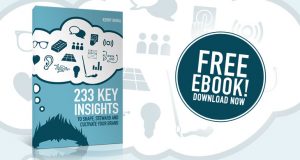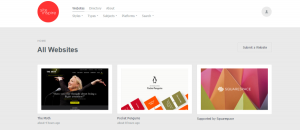I love email.
I mean, really. One of my favorite parts of my morning routine is when I grab my first cup of coffee and start clicking through my emails – even the ones in the notorious Promotions tab.
Are most of them useless? Sure. But for every 15 random cold emails or promotional eCommerce offers I open, I’m usually able to pick up one or two nuggets of inspiration I can incorporate into my own marketing efforts for the Terminus Demand Gen team.
Things like clever headlines, eye-catching designs, or an interesting piece of info from the handful of marketing and current events newsletters I subscribe to. (P.S. if you’re interested in marketing content, subscribe to The Daily Carnage. You won’t regret it)
I love email enough that I recently had the opportunity to represent Terminus in a panel discussion about the future of email marketing.
I was in good company: the panel also included reps from Delta, BrightWave, and RentPath (one of whom is a board member for Women of Email).
The topic: our thoughts on how email will evolve in the near future and what marketers need to do to keep up.
The main takeaway: email isn’t dead. It is very much alive, and it is a key direct channel driving results for B2B and B2C marketers.
Need some extra convincing? Check out these stats:
- An estimated 293 BILLION emails will be sent in 2019 – that’s 804 million emails every single day.
- Email has an average return of $ 38 for every $ 1 spent. (Some think that number is closer to $ 44/dollar spent)
- Close to half of B2B marketers say email marketing is crucial to their content marketing efforts.
As an account-based marketer, I’m focused on delivering the right message to the right person at the right time. Email is a key channel for delivering that message.
Our discussion reinforced the value of email marketing but also shed light on developments that have the potential to make a huge impact on your email marketing efforts.
Whether you’re practicing ABM or still following traditional inbound methods, check out some of my takeaways below to see how the next generation of email might affect your marketing.
You need to consider accessibility and compliance when building emails.
Don’t be like Domino’s. If you haven’t already, it’s time to have a conversation with your marketing and design teams to review email accessibility guidelines and make sure you’re building your emails with the end user in mind.
Give your copy room to breathe, avoid colors that clash, and choose fonts that are easily legible. You should also consider whether your email code is compatible with screen reading devices.
It’s also critical to consider GDPR and CAN-SPAM compliance. Failing to do so could lead to hefty fines (and big headaches) for your business.
And this one might seem obvious, but I’ll stress it anyway: test your emails on multiple devices and ESPs. If your email looks bad on mobile, you might be missing out on around 50% of your audience.
Advances in AI could make it significantly harder to get in front of your target audience.
Battling the Promotions tab is already hard enough. But as email clients like Gmail embrace advances in AI, it could become even more difficult to get in front of your target audience.
It becomes a question of whether you have to appeal to the algorithm or the person. The algorithm will become the gatekeeper for whether or not your email even gets to their inbox. Will you be doomed to a permanent residence in Promotions, or can you find a way to make the move to Primary?
The silver lining: you can use AI to your advantage. AI and machine learning capabilities can enable your team to send hyper-relevant, hyper-personalized content to your audience. A/B testing could become a thing of the past if you can use AI/ML to auto-generate subject lines and content that are tailored to each individual recipient. Oh, and you can schedule your emails to be delivered at the perfect moment.
Consumers want – and expect – hyper-personalized experiences.
To expand on the previous point: personalization is a core component of a good ABM strategy. That’s nothing new.
But the standards for email personalization are getting higher and many marketers will have to rise to meet them.
Even if you don’t have AI or ML capabilities at your disposal, you can – and should – use the data you have in your CRM to make informed decisions about the emails you’re creating and sending.
Leverage audience segments to send more relevant content, but get creative with your cohorts. Go beyond basic demographic info and brainstorm ways you can segment out your emails based on info like:
- Opportunity Stage
- Past Email Behaviors
- Content Consumption
- Industry or Technographic info
Our team has built out multiple email micro-campaigns that are personalized based on the above (and more). For example, we have a campaign that sends beginner-friendly ABM content to users who have indicated they’re not ready to invest in a full ABM platform but are still interested in an account-based approach.
In some ways, email hasn’t caught up to other direct marketing channels.
The lack of email standardization was a source of frustration all the panelists agreed on.
There’s a growing movement advocating for consistent web standards across all email clients.
This lack of standardization is why it’s important to create responsive emails (and test them on multiple browsers/devices). Remember: an email that looks great in Gmail could look wildly different on Outlook. And the way an email renders on your iPhone won’t look the same when it renders on your Kindle Fire.
So, what’s next for email?
Personally, I think the biggest changes to the way we think about email will have to do with the tech aspects (accessibility, responsiveness, etc.).
With respect to how email advances will influence ABM, here are my thoughts:
- Explore creative ways to segment out your email list. Opportunity stage, technographic data, competitive intel, and other account info are good starting points.
- Advancements in email client algorithms will make it harder to land in the coveted primary inbox. Better personalized emails could combat this, but I also recommend balancing your email outreach with other direct channels (or proactive targeting).
- If you have data at your disposal, use it. This applies to all aspects of your ABM strategy. Use it to make more informed decisions, craft better copy, and send the right content to the right people at the right time. AI will probably help with this in the near future (if you aren’t already using it).
- Create surround-sound campaigns to amplify your brand awareness outside of the inbox. Email imagery/messaging can correspond to display ads, direct mail, and more.
- There’s some cool email tech out there. I know the MarTech landscape is crowded enough already, but check out some of these:
- Email deliverability solutions like SendGrid and 250ok
- Email personalization tools like Movable Ink
- Email testing tools like Email on Acid and Litmus
- Oh, and this invite-only email service taking Silicon Valley by storm: Superhuman
As a panel participant, I was grateful for the chance to share the stage with incredibly talented email marketers who shared a lot of industry knowledge I wasn’t yet aware of. Now that I am, I’m excited to see where email goes in the near future. If you have thoughts of your own, feel free to send them my way.
Digital & Social Articles on Business 2 Community
(14)
Report Post



